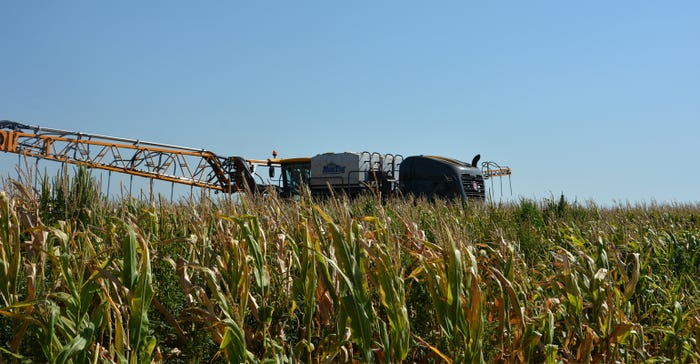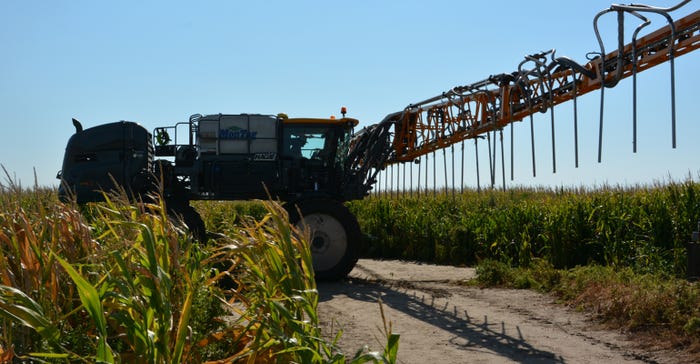Editor's note: A previous version of this story incorrectly reported that John Deere owns Montag. The story has been updated to correct this.
Rice County farmer Todd Oden is getting a head start on getting his grazing cover crops planted ahead of harvest this year, thanks to the arrival of a new piece of machinery at Central Prairie Co-op in Sterling.
Oden, a co-op board member, is one of the first producers to contract cover crop seeding with the new Hagie Montag Interseeder that arrived at the co-op in July. He hopes that getting cover crops seeded in August will mean that the rye mix he’s planting will be tall enough for cattle to graze by the time he harvests the corn.
Oden has been a no-till farmer for several years, but says this is his first venture into adding cover crops and grazing — a decision that makes him part of a growing regenerative agriculture movement that is catching on across the country, partly because it’s being heavily supported by organized efforts and big companies such as General Mills and partly because individual farmers are seeing their neighbors become more profitable because of the change in farming methods.
Central Prairie Co-op manager Brent Werth says his board voted to lease one of the eight new interseeders that have become available in Kansas because they felt it would see good utilization in the Little Ark River and Cheney Reservoir watersheds, where there is strong interest in maintaining and improving the quality and quantity of water in the river, the reservoir and the Equus Beds aquifer, all of which supply both drinking water to the state’s largest city, Wichita. The Equus Beds aquifer is also a major source of irrigation water in south-central Kansas.
He says the new interseeders are a brand new piece of machinery on the market.
Central Prairie Co-op has set per acre cost at $8 per acre application fee for producers who purchase their seed at Central Prairie and $13 per acre flat fee for producers who already have their seed or prefer to purchase it elsewhere.
That compares to about $20 per acre to maintain and use an air seeder to drill the cover crop after harvest.
Using the interseeder also gives the cover crop about 45 to 60 days head start on growing. Werth says the goal is to have the cover crop 8 to 12 inches tall at the time of dry corn harvest.
The Montag fortifier can be removed, and a traditional liquid tank mounted to convert the machine into a conventional sprayer for herbicide or fertilizer as well.
Profitability is strong motive
Oden says his he is glad that a cleaner water supply is a side effect of the regenerative ag movement, but it is the hope of building more organic matter in his soil and keeping precious rainfall in the soil profile instead of in the road ditches is what led him to give it a try. He says he also likes the idea of making a little extra money from leasing some grazing acres while also saving money on winter feed for his own cattle, both of which he thinks will help his farm be more profitable.
The increase in organic matter also promises an increase in cash crop yields, he says. Having the manure and urine deposits across grazed acres enables him to save money on chemical fertilizers.
“It’s a little about making more on cash crops with higher yields and saving money on inputs,” Werth says. “It’s the bottom line that matters.”
Howard Miller, outreach coordinator with the Cheney Watershed conservation group, says he is excited about having the machine available and he hopes it will see good utilization in the area above Cheney Reservoir, which has been the focus of two decades worth of conservation efforts aimed at extending the life of the reservoir and improving the quality of the water that enters it.
 OVER THE TOP: The Hagie Montag Interseeder mounts a Montag fortifier on top of a standard Hagie spray rig to allow the machine go move over the top of standing irrigated corn and drop cover crop seed from the dangling tubes that move through the canopy of the field.
OVER THE TOP: The Hagie Montag Interseeder mounts a Montag fortifier on top of a standard Hagie spray rig to allow the machine go move over the top of standing irrigated corn and drop cover crop seed from the dangling tubes that move through the canopy of the field.

“We have 24 farmers in our group that are part of the General Mills regenerative ag pilot program,” Miller says. “Having the ability to interseed fall cover crops will be a big help to them as that project progresses over the next three years.”
General Mills is working with the regenerative consulting firm, Understanding Ag, to provide agronomic coaching to the producers engaged in the project. Understanding Ag is also providing software to help producers keep records of the data collected during the project. Another partner is the Ecosystems Services Market Consortium to establish a voluntary market that incentivizes farmers for the benefits of regenerative ag, which includes reduced water use, carbon sequestration, improved water quality and reductions in greenhouse gas emissions.
General Mills is operating pilot projects in other areas of the country as well. The company chose south-central Kansas because it wanted to work the wheat farmers who provide much of the hard red winter wheat for its mills.
Water quality effort funding source
The importance of cover crops as a component of a regenerative agriculture program and the role cover crops play in water quality are important to the arrival of the new interseeder technology in Kansas because the funding mechanism for their purchase came though the Kansas Department of Health and Environment’s Clean Water State Revolving Loan, one of the sources of funds for municipalities to build and upgrade wastewater treatment plants.
A northeast Kansas non-profit, Glacial Hills Resources Conservation and Development, purchased eight interseeders. One is being used around the state as a demonstration machine; six have been leased to co-ops in northeast Kansas, where sedimentation of reservoirs is a major issue; and one came to south-central Kansas.
Andrew Lyon with KDHE says that extensive research has shown that widespread adoption of cover crops in the source water area means cleaner water arriving at the treatment plant, which reduces costs for the municipalities and their customers.
 DANGLING SEED TUBES: The tubes that dangle from the boom of the Interseeder move easily through the corn crop canopy without damaging the plants or knocking off ears. Interseeding into the standing fall crop gives the cover crop extra weeks of time to germinate and grow before the cash crop is harvested.
DANGLING SEED TUBES: The tubes that dangle from the boom of the Interseeder move easily through the corn crop canopy without damaging the plants or knocking off ears. Interseeding into the standing fall crop gives the cover crop extra weeks of time to germinate and grow before the cash crop is harvested.

Lyon says that conservation programs of the past have leaned heavily on taking land out of production, which causes economic harm to both farmers and rural communities, while a movement toward regenerative agriculture is a way to not only keep land in production but increase its profitability while building healthier soils, sequestering carbon and improving water quality.
“It also provides opportunity for younger farmers to benefit from the opportunity to get into raising cattle or increasing the size of their herd without having to buy more land,” he says. “If they can lease cover crop acres for grazing, it’s far more economical than trying to own the land. And the landowner gets the benefits to his land and water and cash crops and makes some money from the lease.”
About the Author(s)
You May Also Like






